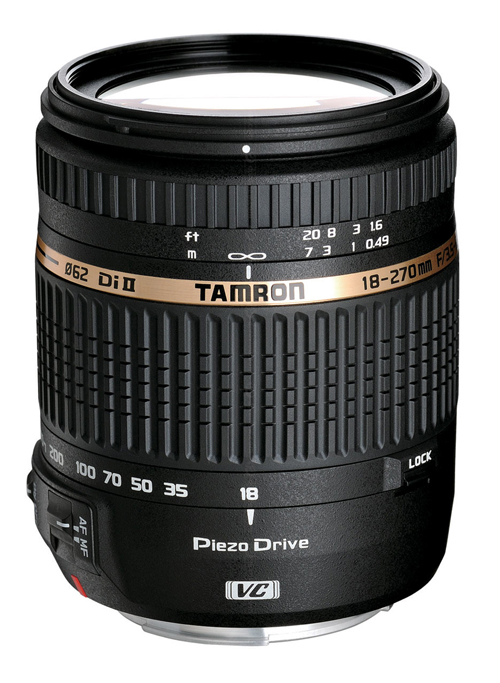Tamron AF 18-270mm f/3.5-6.3 Di II VC PZD
 |
| Gary Wolstenholme takes a close look at Tamron's latest super-zoom which sports a silent piezo ultrasonic focusing motor and an improved Vibration Compensation system. |
Tamron's 18-270mm lenses are pretty unique in that they are the only super-zoom lenses currently available covering such a huge range. This new version which sports a more compact design, silent autofocus and improved Vibration Compensation currently costs around £645. The older version, which is a bulkier optic lacking silent AF, can still be picked up for around £400.
Sigma's closest offering is their 18-250mm f/3.5-6.3 DC OS HSM, which costs around £405 and sports silent focusing and optical stabilisation.
Canon's nearest equivalent is their EF-S 18-200mm f/3.5-5.6 IS USM, which costs around £400. It may lack the pulling power of the Tamron at the long end, but has the benefit of a slightly brighter maximum aperture. The same goes for Nikon's AF-S 18-200mm f/3.5-5.6G VRII, which costs around £560.
Sony users have the DT 18-250mm f/3.5-5.6 AF to choose from, which can be picked up for around £500. Although this lens doesn't have in lens stabilisation, neither does the Sony compatible version of this Tamron lens. Focusing on the Sony optic is powered via the screw-driven focusing system in camera, rather than a silent option like on the Tamron.
As you can see, this new optic from Tamron is amongst the priciest of the superzooms at the moment. Here we'll take a look at whether the extra zoom range and features make the extra expense worthwhile.
Tamron AF 18-270mm f/3.5-6.3 Di II VC PZD: Handling and features
Considering the massive range this lens covers, it is surprisingly compact, and at only 450grams, it is lightweight too. 62mm filters can be fitted to the front, which is smaller than many other superzooms where you will normally find 67mm or 72mm filters being used. The filter thread does not rotate during focus or zooming, which makes this lens ideal for use with polarising filters and neutral density graduated filters.
The lens barrel is constructed from high quality plastics, which feel sturdy enough to take a reasonable amount of use and abuse, without adding too much to the weight of the optic. Zooming in to 270mm more than doubles the length of the lens, which extends in two sections. The zoom mechanism is smooth throughout the range and offers just enough resistance to prevent zoom creep when pointed downwards although in time the mechanism may loosen.
Focusing is pretty snappy, thanks to the new Piezo Drive silent focusing motor. It is noticeably quicker and quieter than the older 18-270mm lens, which can only be a good thing. In low light the lens may hunt a little when shooting at the longer end of the zoom, probably due to the modest maximum aperture. In better light, focusing is accurate and quick for a lens of this type.
The new Vibration Compensation system employed in this lens is partly responsibly for the compact dimensions of this optic. In use it is quick to stabilise the viewfinder image, making composition easier at the equivalent angle of view of a 405mm lens on a 35mm camera. In use I found I could get sharp shots at 270mm pretty much all of the time at 1/50sec, which is three stops slower than the usual rule of thumb would recommend. At 1/25sec I found my success rate dropped to around half the time depending on the subject and conditions.
Tamron AF 18-270mm F/3.5-6.3 Di II VC PZD: Performance
In terms of optical performance, superzooms such as this are normally a minefield of compromises. Although I would never expect this lens to deliver the same quality as say a professional short range zoom or prime lens, it is still quite capable of delivering decently sharp, contrasty images, especially when used at optimum apertures.
Starting at 18mm, sharpness levels are already approaching very good levels in the centre when shot wide open, and the quality towards the edges is acceptable. Stopping down the lens improves centre sharpness to excellent levels and peak quality across the frame is achieved between f/8 and f/11.
As is often the case, zooming in causes a slight drop in resolution, but at 70mm the lens performs acceptably wide open and very good resolution is possible in the centre when stopped down a bit. At this focal length, peak resolution is achieved at f/11 where the sharpness in the centre is very good.
And finally at 270mm, surprisingly the performance of this optic improves over that at 70mm. Again the lens performs acceptably wide open at f/6.3, but really comes into its own when stopped down to f/8. Peak performance is achieved at f/11 again, where the resolution across the frame is very good.
For the most part, levels of chromatic aberrations are kept within acceptable levels. Stopping down the lens appears to make any fringing more defined, so care may need to be taken if taking images with high contrast edges at smaller apertures. Still the levels present at wider apertures hover around half a pixel width, which shouldn't pose too many issues in most images, unless they are printed very large, or cropped heavily.
Falloff of illumination towards the corners at 18mm is reasonably well controlled. At f/3.5 the corners are 1.4 stops darker than the image centre and images are visually uniform at f/5.6. Even at 270mm, the corners are only 1.21 stops darker than the image centre, but the lens needs stopping down a fair bit more visual uniformity isn't achieved until f/11.
Distortion is often a weakness of superzoom lenses, and although distortion is quite pronounced, it isn't as bad with this optic as I've seen with other similar lenses. At 18mm the lens produces 6.27% barrel distortion according to Imatest, which will certainly lead to curvy lines towards the edges of the frame. At 270mm, the barrel distortion is replaced with 1.77% pincushion distortion, which can be quite noticeable in the right circumstances. Luckily the distortion throughout the range follows a uniform pattern, which should make it simple to correct in image editing software afterwards.
For a lens if this type, this optic is quite resistant to flare and ghosting, only showing a lack of contrast and the usual brightly coloured blobs in extreme circumstances, such as shooting directly into the sun when it's low in the sky. A deep scalloped hood is provided with the lens, which does a decent job of keeping unwanted light out of the optic path, reducing the chances of flare occurring with light sources outside of the image area.
Tamron AF 18-270mm f/3.5-6.3 Di II VC PZD: Verdict
Super-zoom lenses have garnered a poor reputation for optical quality in the past, but as technology advances, new lenses have been released which change the public's perception of what to expect. This lens is one of those optics. Its lightweight, compact design makes the lens perfect for travel, especially when paired with a more compact SLR body and during testing it proved itself more than capable of delivering excellent quality results, when used within its limitations.
The lens is very new to the market, and so the current street price may seem a little steep when compared to the competition. The extra 70mm, silent focusing and compact dimensions all make a noticeable difference to the usability of this lens and should be taken into consideration when making a buying decision. As the street price drops a little in time, this should certainly make a compelling choice for those in the market for a convenient one lens solution.
 |
| A decent performer with an impressive zoom range and a great range of features. |
 Respectable optical performance
Respectable optical performance  Compact
Compact Lightweight
Lightweight Vibration Compensation
Vibration Compensation Quick, silent focusing
Quick, silent focusingTamron AF 18-270mm f/3.5-6.3 Di II VC PZD: Cons
 CA levels a little high when stopped down below f/16
CA levels a little high when stopped down below f/16 Higher price than much of the competition at the moment
Higher price than much of the competition at the moment| FEATURES |  |
| HANDLING |  |
| PERFORMANCE |  |
| VALUE FOR MONEY |  |
| OVERALL |  |
Tamron AF 18-270mm f/3.5-6.3 Di II VC PZD: Lens specification
| Price | £645.00 |
| Contact | www.tamron.co.uk |
| Filter size | 62mm |
| Format | APS-C |
| Construction | 13 elements in 16 groups |
| Angle-of-view | 75.6 degrees |
| 35mm equivalent focal length (on APS-C body) | 27-405mm |
| Internal focusing | Yes |
| Image stabilisation | Yes |
| Minimum focus | 49cm |
| Maximum aperture | f/3.5-6.3 |
| Minimum aperture | f/22-40 |
| Weight | 450g |
| Size | 74.4 x 96.4mm |
| In the box | Petal shaped lens hood, lens caps. |
The Tamron AF 18-270mm f/3.5-6.3 Di II VC PZD costs around £645 and and will be available from Warehouse Express soon.
Add your message
Login required
Please login here or if you've not registered, you can register here. Registering is safe, quick and free.
Please login here or if you've not registered, you can register here. Registering is safe, quick and free.
photodo Stats
1102 lenses
428 MTF tests
74 in-depth photodo reviews
100+ users join each day
Help the lens community by reviewing or rating a lens today via our lens search
428 MTF tests
74 in-depth photodo reviews
100+ users join each day
Help the lens community by reviewing or rating a lens today via our lens search
Latest Lens Reviews
- Chinon 28mm f/2.8 Vintage Lens Review
- Canon EF 70-200mm f/4L IS II USM Lens Review
- Samyang AF 85mm f/1.4 EF Review
- Sigma 70mm f/2.8 DG Macro Art Review
- Samyang AF 24mm f/2.8 FE Review
- Meike 50mm f/1.7 Review
- Tamron 70-210mm f/4 Di VC USD Review
- Lensbaby Burnside 35mm f/2.8 Review
- Asahi Super Takumar 50mm f/1.4 Review
- Asahi Super-Multi-Coated Takumar 135mm f/3.5 Review










